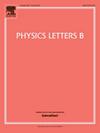Two- versus three-body approach to femtoscopic hadron-deuteron correlations
IF 4.3
2区 物理与天体物理
Q1 ASTRONOMY & ASTROPHYSICS
引用次数: 0
Abstract
The three-body approach to hadron-deuteron correlations is shown to turn into a two-body approach if the three-particle hadron-deuteron wave function factorizes into the deuteron wave-function and the wave function of a hadron motion relative to the deuteron. Then, the hadron-deuteron correlation function is as in the two-body approach only the source radius somewhat changes. For this reason, as we argue, the two-body approach works well for kaon-deuteron correlations but it fails for proton-deuteron ones in case of small sources. Applying the three-body approach generalized to the case where the radius of the hadron source is different from the nucleon source radius, we derive the source radius formula which used in the two-body approach gives the correlation function as in the ‘factorized’ three-body one. The formula is discussed in the context of existing and future experimental data.
求助全文
约1分钟内获得全文
求助全文
来源期刊

Physics Letters B
物理-物理:综合
CiteScore
9.10
自引率
6.80%
发文量
647
审稿时长
3 months
期刊介绍:
Physics Letters B ensures the rapid publication of important new results in particle physics, nuclear physics and cosmology. Specialized editors are responsible for contributions in experimental nuclear physics, theoretical nuclear physics, experimental high-energy physics, theoretical high-energy physics, and astrophysics.
 求助内容:
求助内容: 应助结果提醒方式:
应助结果提醒方式:


